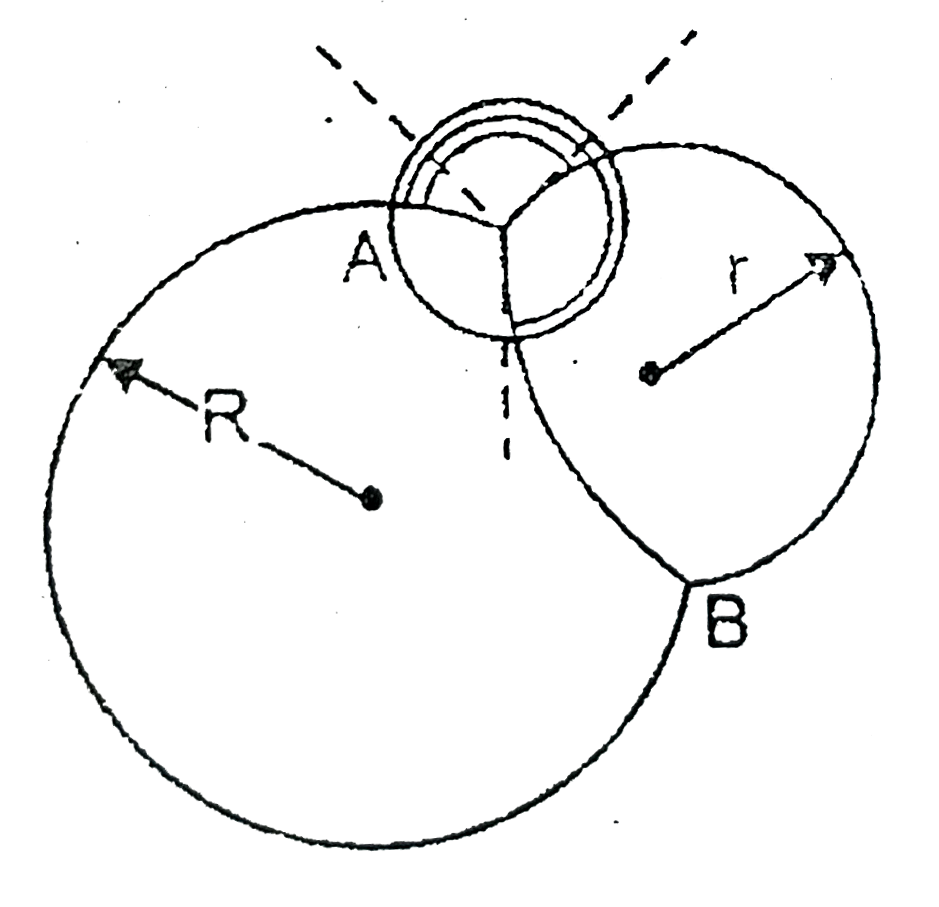A bubble having surface tension T and radius R is formed on a ring of radius b (b<>R) . Air is blown inside the tube held in front of the ring , with velocity υ as shown in fig. The air molecules collides perpendicularly with the wall of the bubble and stops. Calculate the radius R at which the bubble and stops. Calculate the radius R at which the bubble separates from the ring.

The correct Answer is:B, D
KEY CONCEPT: When the force due to excess pressure in the bubble equals the force of air striking at the bubble, the bubble will detach from the ring.
∴ρAv2=4TR×A⇒R=4Tρv2
Topper's Solved these Questions
- MECHANICAL PROPERTIES OF MATTER AND FLUIDSBOOK - SUNIL BATRA (41 YEARS IITJEE PHYSICS)CHAPTER - MECHANICAL PROPERTIES OF MATTER AND FLUIDSEXERCISE - Subjective Problems
1 Videos
- LAWS OF MOTIONBOOK - SUNIL BATRA (41 YEARS IITJEE PHYSICS)CHAPTER - LAWS OF MOTIONEXERCISE - JEE Main And Advanced
79 Videos
- MOMENTUM & IMPULSEBOOK - SUNIL BATRA (41 YEARS IITJEE PHYSICS)CHAPTER - MOMENTUM & IMPULSEEXERCISE - JEE Main And Advanced
30 Videos
Similar Questions
A bubble having surface tension T and radius R is formed on a ring of radius b (b<>R) . Air is blown inside the tube held in front of the ring , with velocity υ as shown in fig. The air molecules collides perpendicularly with the wall of the bubble and stops. Calculate the radius R at which the bubble and stops. Calculate the radius R at which the bubble separates from the ring.

View SolutionA bubble having surface tension T and radius R is formed on a ring of radius b (b<>R) . Air is blown inside the tube held in front of the ring , with velocity υ as shown in fig. The air molecules collides perpendicularly with the wall of the bubble and stops. Calculate the radius R at which the bubble and stops. Calculate the radius R at which the bubble separates from the ring.

View Solution
Knowledge Check
The excess pressure inside a soap bubble P and the radius R of the bubble are related as
Ap∝1/RBP∝RCP∝R2DP∝1/R2The surface tension of soap is T . The work done in blowing a soap bubble of radius 3 R to that of a radius 5R is
A64πR2TB100πR2TC128πR2TD256πR2TA soap bubble of radius r is placed on another bubble of radius 2r. The radius of the surface common to both the bubbles is
A2r3B3rC2rDr
Two air bubbles with radius r are present in water. Are these bubbles attracted or repelled?
View SolutionA soap bubble of radius 1 cm expands into a bubble of radius 2 cm. Calculate the increase in surface energy if the surface tension for soap is 25 dyne/cm.
View SolutionA charged soap bobbe having surface charge density σ and radius r. If the pressure inside and outsides the soap bubble is the same, then the surface tension of the soap solution is
View SolutionA soap - bubble with a radius 'r' is placed on another bubbles with a radius R (figure). Angles between the film at the point of contact will be -

View SolutionIf R is the radius of a soap bubble and S its surface tension, then the excess pressure inside is
View Solution
